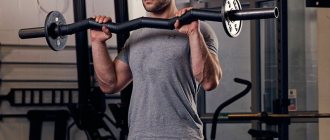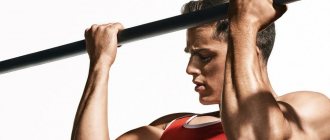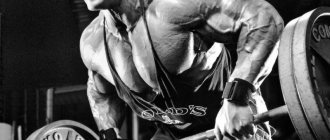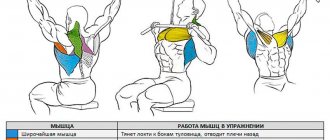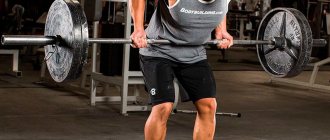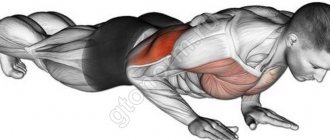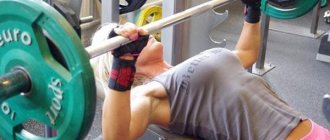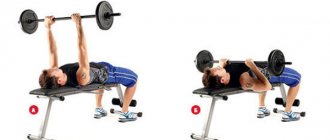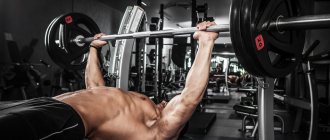The reverse grip press is one of the best exercises for training the triceps, which allows you to most intensely load all three bundles that make up the triceps. Unlike the close-grip press, this exercise does not load the hands, which allows you to effectively pump the triceps even if you have weak hands. But, in general, if you are not faced with the task of developing strength indicators, then for muscle hypertrophy, the reverse grip press is the most effective of all exercises for training the triceps.
Triceps are often underestimated, giving preference to training the biceps, but this is not correct, since anatomically the bulk of the arms is occupied by the triceps, which, among other things, also allows it to be trained more intensely than the biceps. In other words, if you want to pump up your triceps, then you need to include this exercise in your training program.
Execution technique
- You should take a lying position on a horizontal bench. Do not lift your spine from the surface of the bench. You need to position yourself so that the bar is at eye level.
- The legs serve as supports and should be set wide to better stabilize the position.
- You should start the exercise with a warm-up approach with a classic grip.
- After the warm-up approach, you need to take the bar with a reverse grip. Hands are positioned shoulder-width apart.
- The barbell can only be removed with the help of a partner.
- The process of lowering the barbell is slow, with control of the elbows, which should move along the body and not diverge to the sides.
- The upward and downward movement occurs smoothly without jerking.
What muscles does the reverse grip bench press work?
The main part of the load in the bench press with a reverse grip falls on the upper
(clavicular)
part of the pectoral muscles.
It is due to their contraction that the initial phase of lifting the barbell upward occurs.
Next, the front heads of the deltoids .
And the last to be included in the work are
the triceps
.
Due to their reduction, the “pressure” phase occurs. Also, when performing this press, the biceps
. It can be felt when the barbell is lowered. It acts as a stabilizer for the elbow and shoulder joints and also flexes the arm. In addition to the main ones, stabilizer muscles are involved in the exercise. These include:
- Leg muscles. They stabilize the lower body, giving us a more stable position on the bench.
- Back muscles. Responsible for the position of the shoulder blades.
Recommendations
- Use light bars. You only need to work with a barbell with a full grip, in which the bar is completely wrapped around your fingers. You should not allow partial grasping or simply perform the exercise with the bar on the back of your hand.
- Having decided on the weight, the athlete must perform three sets of ten repetitions. You should not do more reverse grip bench presses, as this exercise puts a lot of stress on the ligaments.
- Please note that the movement is performed strictly vertically. It is very dangerous if the barbell moves towards the abdomen. Doing this can cause serious injury to the deltoid muscles.
- When the bar moves in the opposite direction - towards the head, the risk of injury to the neck or head increases, thereby injuring the serratus anterior muscles. When spreading your elbows to the sides, the load will be distributed not only to the triceps and upper chest, but also to part of the back.
Recommendations for implementation
- It is important that the bar goes down, describing a semicircle. We start the movements from the middle of the pectoral muscles, and lower them to their lower part.
- During movement, the elbows should be pressed to the body. There is no need to move them apart. This will place additional stress on the elbow joints and can lead to injury. If you cannot work with this technique, then you have taken too much weight.
- There is no need to lower the barbell to the top of your chest. This will not help you increase the load on that muscle group. At the same time, the risk of dropping the bar increases. The same applies to lowering to the stomach. This technique greatly overloads the deltas.
- We press the bar up, twice as fast as we lowered it. This will allow you to properly feel the stretching of all the muscles involved in the movement. And it will create a peak load during the bench press itself.
- In order to minimize the risk of the bar falling, it is worth performing the exercise with a partner. Who will insure you and at the right moment, will be able to pick up the barbell or help you push it up.
- Never use an open grip. The thumb must be wrapped around the bar. This is your insurance that will prevent the bar from falling.
- Don't bend your wrists too much. This way you will only injure them.
Let's consolidate the above. We press the barbell under control. We try to feel the work of the target muscles. We do not spread our elbows to the sides. Lower the barbell to the bottom of your chest. Don't forget to breathe correctly. Inhale as you lower, exhale as you push.
Analysis of the exercise
What muscles work
The lateral head of the triceps works primarily. Additionally, the muscles of the forearms are involved. The body and legs are included in the work as stabilizers. The exercise is isolating, so bending the body and additionally engaging extra muscles is best avoided.
Inclusion in the program
The movement is included in the training program at the end of the session, and serves to “finish off” the target muscle groups. It can be the last exercise performed on bench press day, or included in the second or third superset on arm day.
The fact is that this movement is difficult to perform with significant weight and therefore cannot be the main one.
Some people have problems with the reverse grip. Technically, the exercise appeared in the training plans of strength athletes in order to strengthen the wrist and the lock grip. Subsequently, it took root in bodybuilding as a way to additionally connect the forearms to the work.
Currently, it is used quite rarely, and solely as a way to make training more varied, and not as a movement of the main format.
The exercise is suitable for both male and female training. Despite the unusual starting position, it is not highly coordinated or difficult, and can be included in the training of beginners.
Common mistakes
- Overweight;
- Cheating with the whole body;
- Pushes due to stepping on the toes;
- Active extension in the elbow joint and not controlled, but sharp flexion;
- Too sudden movements of the arms and body;
- Grip at different widths and, as a result, work with elbows with different amplitudes
Performance Recommendations
- Perform 10-15 repetitions per set, do no more than 3-4 approaches;
- Start with minimal weight and work your way up from workout to workout;
- Perform using clean technique, without jerking or pushing;
- Avoid leaning your body forward too much
- From time to time, replace the exercise on the block with an exercise with rubber, attaching a handle to the free end. This will help develop the triceps more evenly;
- Avoid curling your biceps too hard; this exercise is not for the biceps, but for the triceps;
- Perform the exercise as an additional exercise, you can alternate from workout to workout with a regular triceps extension with a pigtail
Types of execution
♦ using the head down option will allow you to place more load on the lower part of the chest, minimizing the load on the front deltoids;
♦ if you perform the exercise on an inclined bench with your head up, then the upper chest, triceps and even more strongly the anterior delta receive the primary load.
Grips when training with dumbbells.
Dumbbells should always be held with a closed grip. Unlike the barbell, in exercises with dumbbells it is possible to change the grip directly during the exercise; this is often used. Holding the projectile at the starting point with one grip, we change it to another at the end point.
An example of changing between a straight, neutral or reverse grip would be an Arnold press or dumbbell lateral raises where we supinate or pronate the dumbbells as we press to the top. In exercises with dumbbells, the width of the grip is the distance between the hands, which is also customary to change in some exercises, bringing the hands together at the top point and spreading them out at the bottom, for example, when bench pressing dumbbells.
The ability to use these techniques gives dumbbells an advantage over the barbell, which allows for a more diverse impact on the muscles and, ultimately, a beneficial effect on their development.
Advantages and disadvantages
Among the advantages of the reverse grip barbell press exercise, we note:
- Unusual biomechanics of movement, which innervates muscles differently
- Reduced load on the shoulder joint, since this movement is more physiological for the shoulder
- Greater load on the upper chest compared to the classic bench press
- Ability to retarget the load on the pectoral muscles or triceps
As in the case of the classic bench press, by changing the grip width, you can more accurately target muscle groups.
A wide grip puts more stress on the pecs, while a narrow grip (shoulder-width apart) puts more stress on the triceps.
However, this exercise also has disadvantages:
- An assistant is required
It helps to remove the bar from the racks and return the projectile to its place. He also carefully monitors the exercise, since there is a high risk of the projectile falling onto the chest.
- Uncomfortable position for the wrists, especially when training with a heavy barbell
- Unusual movement can reduce concentration on pumping target muscles
Contraindications for athletes
However, standing biceps curls with a reverse grip may not be useful for all athletes. And there are reasons for this. There are a number of contraindications to performing this exercise. First of all, these are lateral and medial epicondylitis and degenerative injuries of the elbow joints, ligaments and tendons. If you experience these or similar problems, doing barbell curls with a reverse grip will be accompanied by severe pain, even no warming or pain-relieving ointments will help. “Hammers” with dumbbells are also not recommended for such ailments.
There is no need to endure this pain; it is better to replace this exercise with something else, for example, a biceps curl on a lower block with a rope handle. These exercises are similar in biomechanics, but moderately intense work with a cable handle should relieve you of pain in your elbows and forearms when performing the exercise.
Arm extension with a dumbbell: tips
Do not forget that violation of the technique in any case will lead to a lack of effectiveness from the training and, in some cases, even to serious injuries. Be sure to watch your back and not round it, as this can cause your torso to lean forward, which in turn will put too much pressure on your shoulders and spine.
Therefore, your back should remain straight until the very end of the set. During the exercise, the part of the arm from the shoulder to the elbow must be fixed in a vertical position, otherwise the exercise, in fact, will practically lose its meaning or the effect from it will be minimal due to excessive pressure on the elbow.
By straightening the arm until the elbow is locked, the athlete strengthens the contractions of the triceps, but then there is a slight relaxation of it, due to the fact that the arm bone becomes a new point of support for it. This position of the elbow joint is very dangerous if the arm deviates vertically. Therefore, only when you are absolutely sure that your arm is perpendicular to the floor can you perform a maximum straightening of your arm.
Safety
The reverse grip bench press is a complex exercise, so it must be performed with the help of a spotter. Otherwise, you will not be able to lift the weight correctly. In addition, a spotter will help you “catch” the barbell when you are unable to complete a repetition.
This type of bench press is not recommended for poorly trained beginners. The fact is that this exercise involves a large number of muscles, which must be toned, otherwise the press will not be performed correctly.
To protect the spine from damage, it is recommended to press your shoulders and pelvis tightly against the bench . A natural S-shaped deflection is allowed in the lower back. However, it is important to ensure that your spine does not move when you lift the weight.
The exercise should not be done by athletes who have recently recovered from an arm or hand injury. Despite the fact that the hands are weakly involved in the press, they can suffer again if the injury was recently received.
What muscles work in the bench press on a block machine?
In the bench press in a block machine, the triceps receive the main load; it has three heads, which is why it is called the triceps brachii muscle. Most of the load goes to the medial head and lateral (side). But we can also use the third long head, just change the grip.
- Lateral head of the triceps. Located at the back of the side of the arm. Its good development will give the triceps an ideal shape, which is often represented in the form of a “horseshoe”; it will start working only if there is not enough effort at the medial head.
- Long head . Located behind, closer to the back, its task is to extend the elbow, so it participates in all triceps exercises, but takes a secondary part. She also fixes her hand near the body. This head is the largest and gives the hand the greatest massiveness.
- Medial head. Located in the upper back of the shoulder, it is the smallest among the three heads of the triceps, but at the same time it takes on the first load when extending the elbow.
Read more about the triceps muscles here
Reverse Grip Press Variations
Reverse grip press with dumbbells
Reverse press can be performed with dumbbells. This option allows you to work each pectoral muscle independently of each other. This makes it possible to reduce the imbalance in their development. This is especially true in the initial stages. Also, working with dumbbells implies the inclusion of a large number of small stabilizer muscles. Thanks to this, they are strengthened. Giving us the opportunity to increase working weights in basic exercises. As for the load on the wrist joints, it will be less than when working with a barbell. Since when working with dumbbells, it allows you to rotate the hand in any direction. Therefore, we can choose a position in which we will not experience discomfort or pain in the wrists. The rest of the technique is the same as in the version with a barbell.
Smith Machine Reverse Grip Press
The Smith machine allows you to work the pectoral muscle in more isolation. Since the barbell is secured on both sides, we don’t have to worry about dropping it in the wrong place. Also, this simulator is equipped with special safety stops. Therefore, you can safely perform the bench press without a partner without fear of dropping the barbell on your chest. But among all the advantages, there is one small disadvantage. I said earlier that we press the barbell along an arcuate path. In the Smith simulator, we cannot do this. Consequently, the bar will rise and fall along a trajectory that is not entirely natural for us. In the lowest position, the elbow joint will be pinched. This problem can be solved by shortening the amplitude. That is, we do not lower the bar all the way down and do not press it completely. The amplitude will be different for everyone. You need to start from your feelings.
Hummer Reverse Press
Lever simulators are no longer uncommon. Increasingly, athletes are using them in their training. Performing the bench press with a reverse grip is very comfortable. The pectoral muscles will be worked in isolation, by excluding the stabilizer muscles. We no longer need to worry about dropping a burden on ourselves. The bench press in a lever machine occurs in an arcuate amplitude, unlike Smith. Therefore, the movement will be more natural for us. And of course, we can work without a partner, even with heavy weight. It is believed that hummers are inferior in effectiveness to basic exercises. Therefore, it will be much more difficult to build muscle mass with their help. But if you want to score muscles at the end of a workout, then the hummer has practically no equal.
Common mistakes
The main mistake made when performing close grip bench presses is using too much weight. Most often, it is beginners who try to prove their strength in this way. There is no need to do this, since untrained arm and back muscles may not be able to withstand this load, and the workout will end in injury.
Also, novice athletes, under the influence of heavy weight, begin to tear off their legs and pelvis . Such actions are not very safe for the health of joints and muscles, since the load begins to be distributed unevenly. If you can’t keep your body on the bench and your legs on the floor, then you need to slightly reduce the weight.
Do not forget about maintaining the correct breathing technique . At the top point of the amplitude, a sharp exhalation is made, which helps to complete the press, and at the bottom, inhale. While squeezing the barbell, it is very important to hold your breath for a couple of seconds so that the muscles can gain additional strength and the spine remains motionless.
Don't be shy about asking for help from trainers at the gym or complete strangers. The bench press is exactly the kind of exercise that cannot be performed without the help of a friend. If you do it yourself, keep in mind that no one can help you complete the set.
Adviсe
- This exercise can be done not only with a barbell, but also with dumbbells - choose the best option for yourself.
- Use a peak contraction, holding the weight at the top for 2-3 seconds to maximally load the target muscles.
- Work in full amplitude and do not hold the weight at the lowest point.
- Do not help yourself with your body while lifting weights.
- To get good results from your training, use as heavy weights as possible, but keep it in moderation. If you can't do the required number of repetitions with the correct technique, reduce the weight of the barbell.
